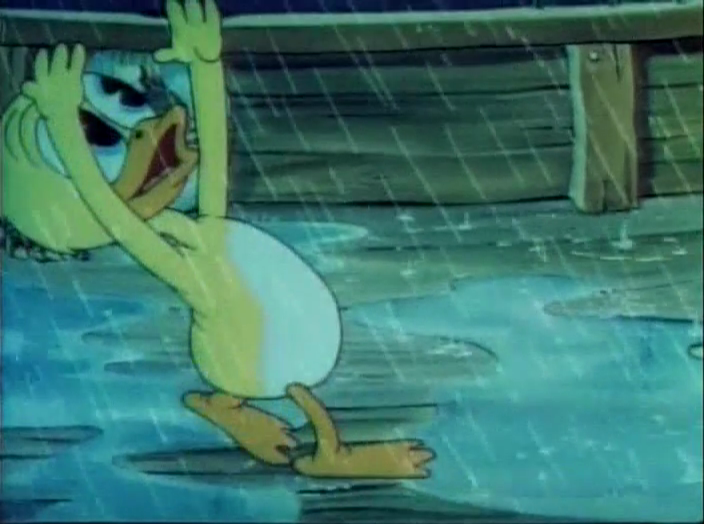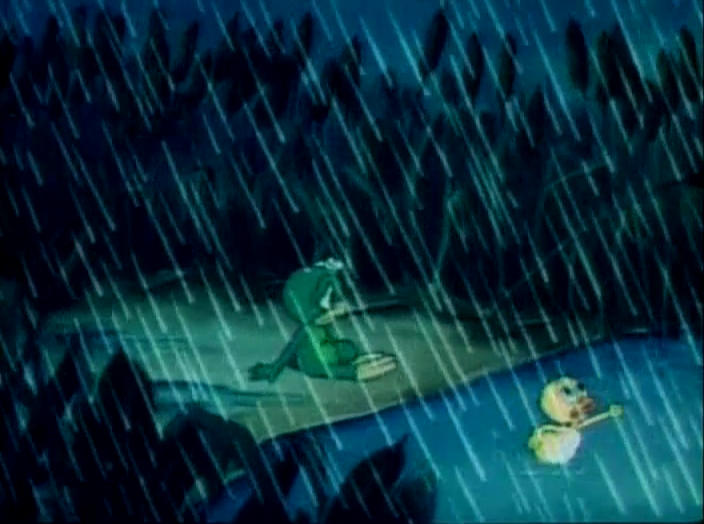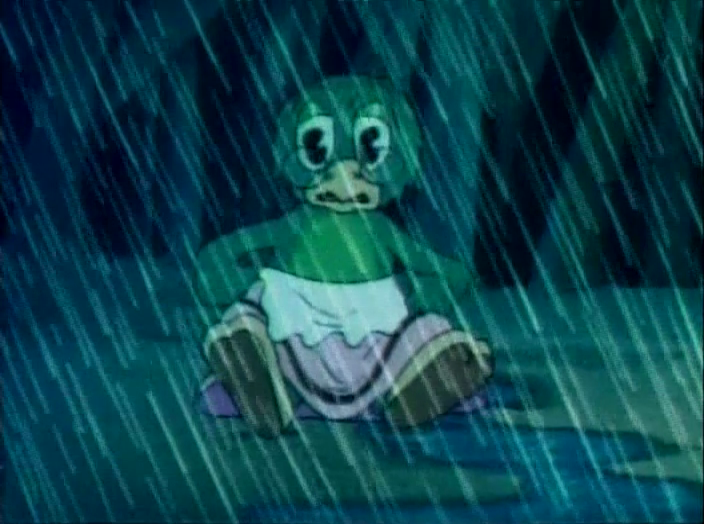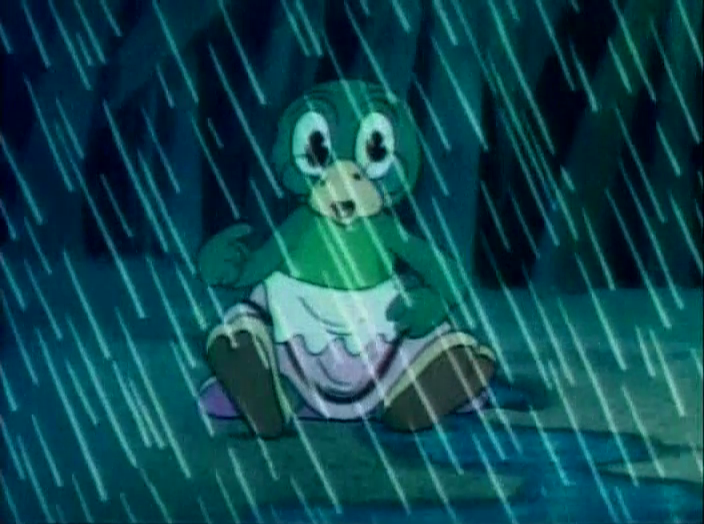DVD/BLU-RAY AVAILABILITY: Kid Galahad DVD (part of WHV's Gangsters Collection, v.4)
You can view a fuzzy but acceptable print of this cartoon HERE.
Thanks to our good bud Devon Baxter for hosting this cartoon. Devon has a great collection of classic cartoons online, and a visit to his DailyMotion account will yield hours of enjoyment.
Two weeks after the release of Porky's Garden comes this, the last of the Avery Unit Depression of 1937. After this, Avery's output will become more bold, daring and funny. Even when the cartoon itself isn't so hot (e.g., The Sneezing Weasel), its first attempts at ideas Avery will later perfect at M-G-M make the work more vital and important.
As with Avery's prior Merrie Melodie, A Sunbonnet Blue, I Wanna Be a Sailor lacks the intense commitment that we saw in Avery's 1936/7 pictures, right up to Uncle Tom's Bungalow, and scarcely exhibits its creator's personality. With this the fourth mediocre film in a row, it would appear that Avery was either burned out or prevented, in some unknowable way, from giving his work 110%.
Self-critical to a fault, Avery certainly would have noticed this dip in quality, and been driven to make better pictures. With this cartoon, he did manage to excise a song or production number. The end result plays like a Max Fleischer Color Classic--with lower production values and a couple of welcome inversions to the morality-play so typical of late '30s Hollywood cartoons.
This dry spell of inspiration suggests (and, please note, this is just pondering, not fact) that Avery was in a painful game of hide-and-seek with himself. He had directed 20 cartoons for the Schlesinger studio, this one included. His efforts, and those of his unit, were appreciated by audiences and the front office.
He'd quickly been promoted to the Merrie Melodies, but with the tacit proviso that he soft-pedal the antic side of his sensibility. In the Technicolor cartoons of 1936 and '37, we see Avery in a constant struggle--please the boss, or please himself? (end of personal conjecture)
At the Depression's tail end, as now, job security trumped personal convictions. Avery had made one genuine crowd-and-boss-pleaser that also included his comedic DNA (I Love To Singa) and one self-pleaser that archly neglected either demographic (Uncle Tom's Bungalow).
The rest of his color cartoons of this period are half-hearted attempts to make the boss happy, with almost grudging inclusions of his own comedic voice. Compare, say, Ain't We Got Fun to The Blow-Out. The discrepancies are heart-breaking. Both films are the work of a skilled movie-maker with a vision. The earlier cartoon is a whole-hearted, fully invested work. Its ragged edges are salved by a fearless embrace of the impossible.
Ain't We Got Fun, and its ilk, cower at invention, and, with furrowed brow, deliver tepid material with a barely masked resentment. 77 years later, with the luxury of an overview of Avery's career, it's clear that he could not toe this line too much longer. In 1937, Avery might have felt that he'd sold out, and sacrificed his unique voice for a steady paycheck.
I Wanna Be A Sailor is, thank heavens, the final film in this painful dry streak. Avery returns to the have cake, eat too formula of I Love To Singa, injects a few personal touches and wraps up a harmless cartoon with the least amount of effort or woe.
As Avery might have said to his staff, "wellp, fellas, let's get this over with..."
Iris in on Momma Parrot, who drills her three children in their essential phrase, "Polly want a cracker?"
Avery enjoyed taxing an audience's patience with realistic ramblings of over-cute children.
Patrick struggles with Spoonerisms, but delivers the goods. Sister Patricia's overly unctuous voice is an Avery tell. She winsomely spits out the desired phrase, to parental praise...
The third time's the charm in Avery's universe, so we know that last child will break the pattern. Peter looks POd from his first appearance, and clearly has no patience for this drill. Keith Scott tells me that Robert Winkler, the last voice actor for the "Scrappy" character in Columbia cartoons, did Peter's role.
"I don't wanna cracker, see? I wanna be a sailor, like me pa--SEE?"
(note Popeye forearms on Pa Parrot)
This declaration does not please Ma Parrot."That sea-farin' home-wrecker! That high seas hitchhiker!" And on she rants, until a flashback sequence at 1:25, which welcomes back the animation of Irv Spence, so painfully absent from Porky's Garden:
The narrative is best expressed via Elvia Allman's marvelous voice performance in the film itself, so watch the cartoon, as you're always advised to do before plowing through my pontifications...
Pa Parrot's drinking cycle harks back to pre-Hays Code cartoons.
On his way out, Pa corrects Ma's flashback narration, which she amends in the present tense. This is a lovely example of what Avery could do that no-one else in the cartoon community was then doing.
A stock Avery gag follows... "I used to burn a little light in the window..."
Back to the present, Ma continues her derisive rant of her good-f'r-nuthin' spouse, then asks Paul if he still wants to be a sailor.
Tearfully, regretfully, Paul answers...
"Yes...."
Ma does an Avery take and faints, feet still gripping the perch bar.
As in I Love To Singa, the estranged son strikes out on his own.
A matched shot changes Paul's walk-cycle from a flat interior to a multi-planed exterior. This novel touch is a sharp piece of film-making, and is flawlessly achieved. Such clever touches were a real crap-shoot, given the lack of preview options. One had to trust the camera operator, film editor and the film lab to make this complex idea come to light.
Paul literally runs into the end of Act One--and the answer to his unfulfilled goal.
Avery's cartoon physics decree that, if an object suits a character's mood or needs, he or she can pick it up, regardless of its weight, or any other proportional issues that might otherwise thwart their efforts.Fade to black. Another multi-plane shot, which moves right to left, reveals the end-game for the barrel, and introduces a willfully irksome new character...
This nameless, unceasing chatterbox anticipates Friz Freleng's Little Blabbermouse and Chuck Jones' Sniffles. He will, later, revive a gag from a Walter Lantz Oswald cartoon on which Avery worked.
The duck's motormouth and curiosity don't wear well with Peter, see?
Peter's prideful, Cagney-esque boast is capped with a reprise of the hormonal "today... I am a... man!" gag, which, though originally part of the Bar Mitzvah ceremony, came, I'd imagine, from a contemporary radio show.This proven laugh-getter of parroting pop culture was already a Schlesinger staple, and proved a great way to connect with movie audiences. That the references often make no sense, long divorced from their original context, make them quaint non-sequiturs for most millenial viewers.
Jabberjaw duck excitedly asks to become Peter's first mate.
Cut to conveniently-placed clothes pin.
Peter now starts a 1937 ur-rap about his nautical ambitions.
With more Irv Spence animation, chatty duck is commanded to swab all decks.
Neck-wringing is threatened upon failure to comply.
Peter flies an ersatz Jolly Roger.
The home-brewed ship sets sail. This sort-of-cute business is handled painlessly by Avery and staff.
One brief bit that harks fondly back to Picador Porky:
"I'm the captain's kid..."
"SEE?"
Peter looks up admiringly at his union-suit sails.
He then asks our opinion, in a refreshing jolt of pure Avery humor:
"This picture's kinda like Mutiny on the County, don'cha think?"
[pregnant pause]
"Or don'cha?"
The impetus of this gag must have been to show Peter spitting on-screen.
Chew spew has GPS; finds underwater spittoon.
Peter does that eerie bird beak-and-claw climbing thing to get an eagle's nest view of the sea.
A take alerts us that something's gone south.
Lightning that spells out its own onomatopoeia is a minor but persistent Averyism.
Peter freaks out, and babbles orders to the still-clothes-pinned duck:
In this moment, a sleeping giant--Avery's true, confident comedic self--awakens, after a long, fitful unrest:The hyper-talkative duck jibbers away, extolling the joy of stormy weather, when he addresses the audience:
"Ain't I the talkingest little guy?"
In the middle of a routine, potentially disappointing cartoon, Avery once again makes films that are enjoyable for creator and audience. Hallelujah!
The ceiling of Schlesinger's budget, and its artistic-technological competency, is keenly felt in such special-effect laden scenes. The highly stylized water, with its shark-fin crests and amorphous donut designs, does not convince for one moment. The blurry double-exposures also betray small budgets and learnt-on-the-fly technical prowess.
Of course, if this were perfectly animated, it would likely cease to be funny and/or entertaining. There's the rub.
Of course, if this were perfectly animated, it would likely cease to be funny and/or entertaining. There's the rub.
As Peter loses control of his vessel...
we cut to an Avery cartoon physics gag that, in best
1930s Schlesinger tradition, unfolds slowly and is repeated.
1930s Schlesinger tradition, unfolds slowly and is repeated.
Chatty Duck revels in the rain, in a moment cribbed from one of Avery's last
Oswald Rabbit pictures, 1934's Five and Dime:
The Five and Dime gag is funny, but randomly underplayed. Avery gives it confident front-and-center status, and focuses on one duck's enjoyment, in medium shot.Oswald Rabbit pictures, 1934's Five and Dime:
Peter is thrown asunder by the ship's wheel.
His attempt to tether the ship to the sea floor fails...
...and the craft goes down.
Duck, in ocean orgasm, jumps with joy into the drink.
Peter proves himself panicky and unseaworthy.
His cries for help easily reach the dry safety of home,
which reveals that his journey was not far at all.
Ma Parrot rushes to son's aid.
Avery has the reins in his control, and assertively inserts irreverence.
Ma breaks into a Stephen Foster song, and adopts a truckin' pose.
She then returns to melodrama mode.
Meanwhile, the duck is disgusted with Peter's pathetic flail. The former captain has lost all status.
Peter goes down, and again chooses to mock his potentially serious predicament.
Peter's shave-and-a-haircut "Help"s offer another bracing, unexpected moment.
Duck sucker-punches parrot...
...and tosses him back ashore.
"Ya big sissy!"
Duck exits the picture, and returns to his rhapsody in the rain.
Avery understands our expectations. We're accustomed to the delivery of a moral, at this point in the story. Though its effect has been dulled by 77 years of familiarity and imitation, this ending is a triumph over the Disney way of righting wrongs and conforming to the norm.
"Now. You don't want to be a sailor, do you?"
[sniffly, seemingly repentant]: "Y-yes..."
Avery reuses the take from earlier in the cartoon.
We know that the iris out is never a guarantee of closure in Avery's world.
For once, a character does not force the retina out.
It widens of its own accord, as Ma Parrot addresses the audience:
It widens of its own accord, as Ma Parrot addresses the audience:
[sighs] "Now what would you do with a child like that?"
The rain disappears at the final iris-out.
I Wanna Be A Sailor begins in discouragement and ends in triumph. How or why Avery regained his footing is lost to time. It's heartening to watch it all come into focus for Avery and staff in the seven minutes of this cartoon.
Avery is not the only Schlesinger director to have off-periods. Bob Clampett will flounder in his 1939 and 1940 films, and Chuck Jones will take five or six years to get ahold of his comedic and cinematic mojo. Because Avery was such a trail-blazer, and his comedic stance much more revolutionary, his ups and downs seem more dramatic, in retrospect.
We're on the verge of one of Avery's golden periods as a comedian and movie maker. It will be a genuine joy to explore these cartoons in depth with you.
Thanks to Keith Scott for his well-researched voice identifications in this and other Avery cartoons.
UP NEXT: A Fractured Fairy Tale in Colored Pencils--Little Red Walking Hood






























































































































































There was just something about the idea of a fast-talking character who won't shut up that Warners loved -- aside from the above-mentioned Freleng and Jones shorts, the duck also turns up in Hardaway and Dalton's "It's An Ill Wind" and Clampett's "Porky's Hotel". Going by the dogged determination that there's something hilarious about the idea, you can conjecture that Avery & crew expected him to be regarded as funnier by the audience than he was, and not as annoying to the viewers in the theater as he was to the others in the cartoon. Which would also explain why every unit except for Tashlin and Norm McCabe took a whack at the premise over the next nine years -- if at first you don't succeed, try it eight more times.
ReplyDeleteSo unlike, say, "A Sunbonnet Blue" where Tex seems to be trying to give the theater owners the type of pseudo-Disney color cartoons they're reflexively asking for (while hating just about every moment of making it), this one's more like "Egghead Rides Again" where Avery's trying to aim for what interests him, as opposed to trying to please others, but misses the mark with the cartoon's main comedy idea.